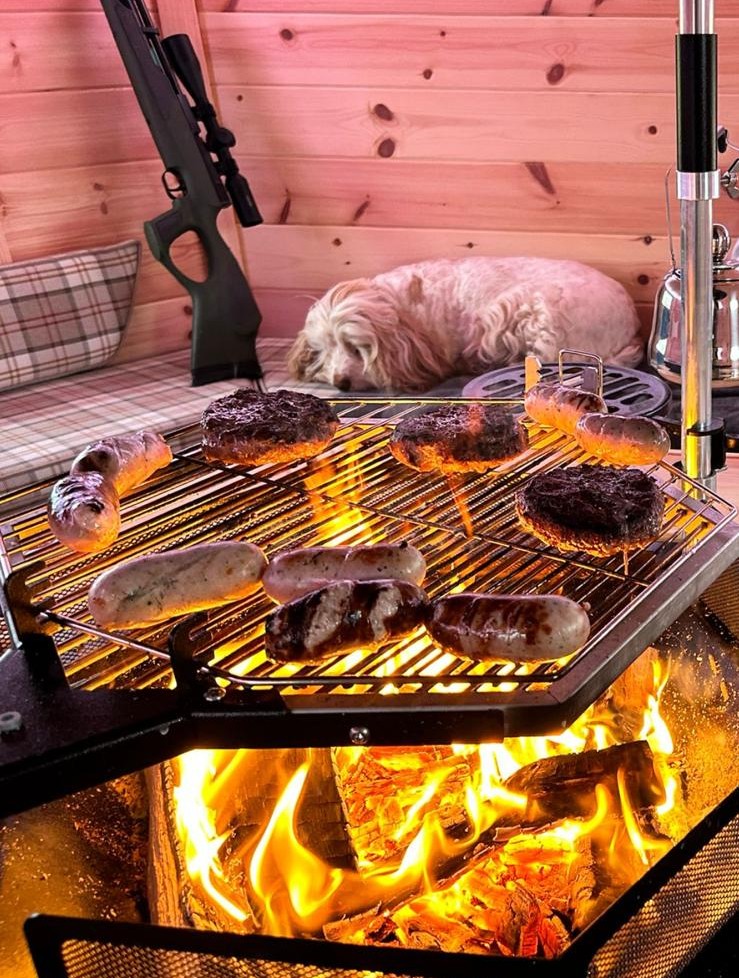Whether cooking in a bbq cabin, or anywhere with charcoal, here is some info that could totally up the result of your culinary offerings!
Cooking Over Charcoal
History
Cooking over charcoal is an ancient technique that traces its origins to early human societies. As early as the Bronze Age, humans discovered that charcoal, a form of carbon residue from burned wood, provided a reliable and efficient heat source. Charcoal became particularly significant during the Iron Age, where its high heat capabilities were essential for metalworking.
Charcoal's consistent burn and ability to reach high temperatures made it ideal for cooking. Over centuries, various cultures adopted and refined charcoal cooking methods, leading to diverse culinary traditions, from the American barbecue to Japanese yakitori.
Types of Charcoal
There are two primary types of charcoal used for cooking: lump charcoal and briquettes.
Lump Charcoal: Made from pure wood chunks burned in the absence of oxygen, resulting in pure carbon. It burns hotter and faster than briquettes, providing a more natural wood flavour. It lights quickly, burns hotter, and imparts a distinct smoky flavour that is highly sought after in grilling. However, it can burn unevenly and tends to be more expensive.
Charcoal Briquettes: These are made from compressed charcoal dust mixed with binders and additives to ensure uniformity. Briquettes burn longer and more steadily, making them a popular choice for extended cooking. While they burn more uniformly and for longer periods, the additives can sometimes affect the flavour of the food.
Binchotan Charcoal: A type of activated charcoal from Japan, known for its purity and ability to burn at a steady, high heat for a long time. It is often used in traditional Japanese grilling.
Science of Charcoal Cooking
Charcoal cooking relies on the combustion of carbon in the presence of oxygen, producing heat and a small amount of smoke. This process involves three main stages:
Ignition: When charcoal is ignited, it begins to combust, producing heat.
Flaming Combustion: Initial combustion creates flames, which soon settle into a glow.
Glowing Combustion: Charcoal reaches a steady state of glowing embers, providing consistent heat.
Charcoal can reach temperatures of up to 1,100°F (593°C), making it ideal for searing and grilling. The lack of water content in charcoal results in minimal steam production, ensuring that food remains dry and develops a distinct charred flavour.
Setup:
Setting Up the Grill:
Clean the Grill: Remove any old ash or debris from previous use. Ensure that the grill is clean from any previous cooking sessions. This helps prevent unwanted flavours and ensures even heating.
Arrange the Charcoal: Depending on what you are cooking, you can arrange the charcoal in different patterns:
• Direct Heat: Spread the charcoal evenly across the bottom of the grill. This setup is ideal for quick-cooking foods like burgers and hotdogs.
• Indirect Heat: Pile the charcoal on one side of the grill. This allows for slower cooking and is perfect for larger cuts of meat that require more time.
Lighting the Charcoal: Use a chimney starter for the most efficient and chemical-free lighting method. Fill the chimney with charcoal, place crumpled newspaper underneath, and light it. Once the coals are glowing and covered with a layer of white ash, they are ready to be poured into the grill.
• Direct Grilling: Place food directly over the hot coals. Ideal for quick-cooking items like burgers, steaks, and vegetables.
• Indirect Grilling: Food is placed away from the coals, cooking with ambient heat. Suitable for larger cuts of meat or items that need slower, more even cooking.
Adding wood chunks or chips to the coals introduces smoke, which infuses food with rich, smoky flavours. Maintaining a lower temperature (225-250°F) and using a closed lid helps achieve a good smoke.
Temperature Control:
Air Vents: Adjust the airflow using the vents on the grill. Opening the vents allows more oxygen in, increasing the temperature, while closing them reduces oxygen flow, lowering the heat.
Coal Arrangement: Adjust the amount and placement of charcoal to influence cooking temperature, see above.
Grill Maintenance:
• Preheat the Grill: Ensure the grill is hot before adding food.
• Oil the Grates: Prevent sticking by oiling the grates before placing food.
• Clean After Use: Scrape off any residue after cooking to maintain grill performance.
Techniques for Cooking Over Charcoal
Cooking over charcoal offers a variety of techniques, each suitable for different types of food and desired outcomes.
• Grilling: This is the most common method, where food is placed directly over the hot coals. It’s perfect for searing steaks, cooking burgers, and grilling vegetables. The high heat quickly caramelizes the exterior, creating a delicious crust while keeping the inside moist.
• Smoking: By cooking food slowly at a low temperature with indirect heat, smoking allows the flavours of the wood and charcoal to deeply penetrate the food. This technique is ideal for larger cuts of meat like brisket, ribs, and pork shoulder. Adding wood chips or chunks to the charcoal can enhance the smoky flavour.
• Roasting: Similar to oven roasting, this method involves cooking food over indirect heat. It’s great for whole chickens, turkeys, and other large items that require even cooking. A drip pan can be placed under the food to catch fat drippings and prevent flare-ups.
• Searing and Finishing: This involves first searing the food over direct heat to develop a crust, quick and hot for the grill, and flipping very soon after the meat has gone on.
Conclusion
Cooking over charcoal is a timeless technique that combines ancient practices with modern culinary innovations. Its distinct flavours, high heat, and versatility make it a favourite among cooking enthusiasts. Whether searing a steak, slow-cooking ribs, or infusing food with smoky aromas, charcoal grilling offers a rich and rewarding cooking experience.
At Scotia Cabins, we do not profess to be any form of experts when it comes to cooking on the grills, but we absolutely love hearing about what our customers have created over the years. As a customer, you will get exclusive access to our Scotia Cabins Owners group where you can chat to other owners and share techniques and stories.
We look forward to seeing you soon
01738 850203




